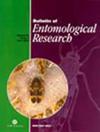侧向求偶行为及其对 Ostrinia furnacalis(鳞翅目:栉水母科)交配成功率的影响
IF 1.6
3区 农林科学
Q2 ENTOMOLOGY
引用次数: 0
摘要
侧化是在越来越多昆虫物种中观察到的一种成熟现象。本研究旨在获得亚洲玉米螟求偶和交配行为侧化的基本细节。我们进行了实验室调查,观察亚洲玉米螟成虫求偶和交配行为的侧化现象。我们的目标还包括检测性互动过程中侧向交配行为的变异,并阐明这些变异如何影响雄虫的交配成功率。我们的发现揭示了两个明显的侧向特征:雄性从雌性的右侧或左侧接近,以及雄性转身的方向。具体来说,雄性从雌性右侧接近时主要表现出偏左的 180° 转向,而雄性从雌性左侧接近时主要表现出偏右的 180° 转向。值得注意的是,与右侧接近的雄性相比,左侧接近的雄性在进行180°转体以实现端对端生殖器接触时,开始交配的尝试次数更少,而且开始交配的时间更早。此外,在性接触过程中,如果雄性随后靠近雌性的右侧,交配成功率会更高。向左转180°的雄性交配成功率更高。这些观察结果首次报道了在受控实验室条件下,O. furnacalis繁殖行为的侧向性,并有望为害虫控制工作中评估和监测大规模生产个体的质量建立可靠的基准。本文章由计算机程序翻译,如有差异,请以英文原文为准。
Lateralised courtship behaviour and its impact on mating success in Ostrinia furnacalis (Lepidoptera: Crambidae)
Lateralisation is a well-established phenomenon observed in an increasing number of insect species. This study aims to obtain basic details on lateralisation in courtship and mating behaviour in Ostrinia furnacalis , the Asian corn borer. We conducted laboratory investigations to observe lateralisation in courtship and mating behaviours in adult O. furnacalis . Our goal was also to detect lateralised mating behaviour variations during sexual interactions and to elucidate how these variances might influence the mating success of males. Our findings reveal two distinct lateralised traits: male approaches from the right or left side of the female and the direction of male turning displays. Specifically, males approaching females from their right side predominantly exhibited left-biased 180° turning displays, while males approaching females from the left-side primarily displayed right-biased 180° turning displays. Notably, left-biased males, executing a 180° turn for end-to-end genital contact, initiated copulation with fewer attempts and began copulation earlier than their right-biased approaches with left-biased 180° turning displays. Furthermore, mating success was higher when males subsequently approached the right side of females during sexual encounters. Left-biased 180° turning males exhibited a higher number of successful mating interactions. These observations provide the first report on lateralisation in the reproductive behaviour of O. furnacalis under controlled laboratory conditions and hold promise for establishing reliable benchmarks for assessing and monitoring the quality of mass-produced individuals in pest control efforts.
求助全文
通过发布文献求助,成功后即可免费获取论文全文。
去求助
来源期刊
CiteScore
4.00
自引率
0.00%
发文量
160
审稿时长
6-12 weeks
期刊介绍:
Established in 1910, the internationally recognised Bulletin of Entomological Research aims to further global knowledge of entomology through the generalisation of research findings rather than providing more entomological exceptions. The Bulletin publishes high quality and original research papers, ''critiques'' and review articles concerning insects or other arthropods of economic importance in agriculture, forestry, stored products, biological control, medicine, animal health and natural resource management. The scope of papers addresses the biology, ecology, behaviour, physiology and systematics of individuals and populations, with a particular emphasis upon the major current and emerging pests of agriculture, horticulture and forestry, and vectors of human and animal diseases. This includes the interactions between species (plants, hosts for parasites, natural enemies and whole communities), novel methodological developments, including molecular biology, in an applied context. The Bulletin does not publish the results of pesticide testing or traditional taxonomic revisions.

 求助内容:
求助内容: 应助结果提醒方式:
应助结果提醒方式:


